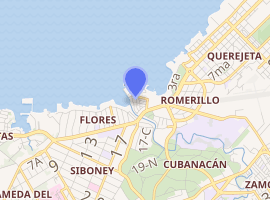Club Náutico
Club Náutico (Nautical Club) was originally built in the 1920s and expanded in 1936 by its owner Carlos Fernández. Guests paid a modest fee (.10 cents), eventually there were more than five thousand subscribers. Fernández had in addition to the enjoyment of a short beach, a dance floor with an orchestra.[1] By the 1950s, an increase in membership necessitated expansion of the original premises in 1953 and Max Borges Recio designed a set of porticos covered by vaults similar to the ones he recently had designed for the Tropicana. It is located at Terminus of 152, Nautico, Playa, Havana, Cuba.
| Club Náutico de Marianao | |
|---|---|
 Arches at Club Nautico, 1953 | |

| |
| Former names | Club de las Panteras |
| General information | |
| Type | Recreation |
| Architectural style | Modern |
| Location | Playa, Havana |
| Address | 5ta Avenida y 152 |
| Town or city | |
| Country | |
| Coordinates | |
| Inaugurated | 1953 |
| Owner | Carlos A. Fernández Campos |
| Dimensions | |
| Diameter | 20' |
| Technical details | |
| Structural system | Arches |
| Material | Reinforced concrete |
| Floor count | 1 |
| Design and construction | |
| Architect | Max Borges Recio |
Architecture
Borges used a Catenary arch, similar to those used in the Tropicana. The English word "catenary" is usually attributed to Thomas Jefferson,[2][3] who wrote in a letter to Thomas Paine on the construction of an arch for a bridge:
I have lately received from Italy a treatise on the equilibrium of arches, by the Abbé Mascheroni. It appears to be a very scientifical work. I have not yet had time to engage in it; but I find that the conclusions of his demonstrations are, that every part of the catenary is in perfect equilibrium.[4]
It is often said[5] that Galileo thought the curve of a hanging chain was parabolic. In his Two New Sciences (1638), Galileo says that a hanging cord is an approximate parabola, and he correctly observes that this approximation improves as the curvature gets smaller and is almost exact when the elevation is less than 45°.[6] That the curve followed by a chain is not a parabola was proven by Joachim Jungius (1587–1657); this result was published posthumously in 1669.[5]
Application
The application of the catenary to the construction of arches is attributed to Robert Hooke, whose "true mathematical and mechanical form" in the context of the rebuilding of St Paul's Cathedral alluded to a catenary.[7] Some much older arches approximate catenaries, an example of which is the Arch of Taq-i Kisra in Ctesiphon.[8]
In 1671, Hooke announced to the Royal Society that he had solved the problem of the optimal shape of an arch, and in 1675 published an encrypted solution as a Latin anagram[9] in an appendix to his Description of Helioscopes,[10] where he wrote that he had found "a true mathematical and mechanical form of all manner of Arches for Building." He did not publish the solution to this anagram[11] in his lifetime, but in 1705 his executor provided it as ut pendet continuum flexile, sic stabit contiguum rigidum inversum, meaning "As hangs a flexible cable so, inverted, stand the touching pieces of an arch."
Color
There is a color differentiation at the Club Náutico between the blue, and smooth surface of the architectural covering of the arch and the white structure above. The arches at the Club Náutico lack the architectural and structural purity that Borges achieved at the Tropicana as most of the arches there are for the most part self-supporting. Here as in the Tropicana Borges used the difference in height between arches to insert a clear glass skylight. The floors are polished concrete.
References
- "¿Quién salvará las playas del oeste de La Habana?". Retrieved 2018-10-10.
- ""Catenary" at Math Words". Pballew.net. 1995-11-21. Retrieved 2010-11-17.
- Barrow, John D. (2010). 100 Essential Things You Didn't Know You Didn't Know: Math Explains Your World. W. W. Norton & Company. p. 27. ISBN 978-0-393-33867-6.
- Jefferson, Thomas (1829). Memoirs, Correspondence and Private Papers of Thomas Jefferson. Henry Colbura and Richard Bertley. p. 419.
- Lockwood p. 124
- Fahie, John Joseph (1903). Galileo, His Life and Work. J. Murray. pp. 359–360.
- Jardine, Lisa (2001). "Monuments and Microscopes: Scientific Thinking on a Grand Scale in the Early Royal Society". Notes and Records of the Royal Society of London. 55 (2): 289–308. doi:10.1098/rsnr.2001.0145. JSTOR 532102.
- Denny, Mark (2010). Super Structures: The Science of Bridges, Buildings, Dams, and Other Feats of Engineering. JHU Press. pp. 112–113. ISBN 978-0-8018-9437-4.
- cf. the anagram for Hooke's law, which appeared in the next paragraph.
- "Arch Design". Lindahall.org. 2002-10-28. Archived from the original on 2010-11-13. Retrieved 2010-11-17.
- The original anagram was abcccddeeeeefggiiiiiiiillmmmmnnnnnooprrsssttttttuuuuuuuux: the letters of the Latin phrase, alphabetized.